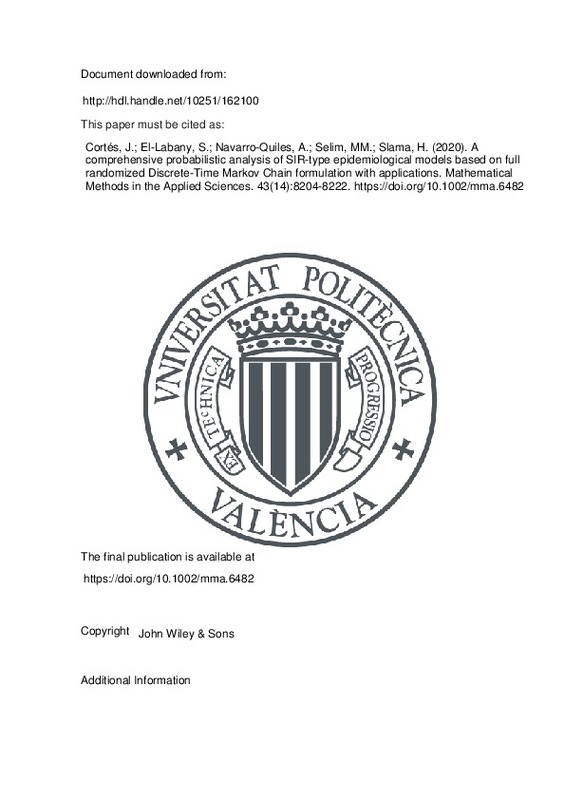Hamra, G., MacLehose, R., & Richardson, D. (2013). Markov Chain Monte Carlo: an introduction for epidemiologists. International Journal of Epidemiology, 42(2), 627-634. doi:10.1093/ije/dyt043
Becker, N. (1981). A General Chain Binomial Model for Infectious Diseases. Biometrics, 37(2), 251. doi:10.2307/2530415
Allen, L. J. S. (2010). An Introduction to Stochastic Processes with Applications to Biology. doi:10.1201/b12537
[+]
Hamra, G., MacLehose, R., & Richardson, D. (2013). Markov Chain Monte Carlo: an introduction for epidemiologists. International Journal of Epidemiology, 42(2), 627-634. doi:10.1093/ije/dyt043
Becker, N. (1981). A General Chain Binomial Model for Infectious Diseases. Biometrics, 37(2), 251. doi:10.2307/2530415
Allen, L. J. S. (2010). An Introduction to Stochastic Processes with Applications to Biology. doi:10.1201/b12537
Hethcote, H. W. (2000). The Mathematics of Infectious Diseases. SIAM Review, 42(4), 599-653. doi:10.1137/s0036144500371907
Brauer, F., & Castillo-Chávez, C. (2001). Mathematical Models in Population Biology and Epidemiology. Texts in Applied Mathematics. doi:10.1007/978-1-4757-3516-1
Cortés, J.-C., Navarro-Quiles, A., Romero, J.-V., & Roselló, M.-D. (2018). Some results about randomized binary Markov chains: theory, computing and applications. International Journal of Computer Mathematics, 97(1-2), 141-156. doi:10.1080/00207160.2018.1440290
Cortés, J.-C., Navarro-Quiles, A., Romero, J.-V., & Roselló, M.-D. (2017). Randomizing the parameters of a Markov chain to model the stroke disease: A technical generalization of established computational methodologies towards improving real applications. Journal of Computational and Applied Mathematics, 324, 225-240. doi:10.1016/j.cam.2017.04.040
Casabán, M.-C., Cortés, J.-C., Romero, J.-V., & Roselló, M.-D. (2015). Probabilistic solution of random SI-type epidemiological models using the Random Variable Transformation technique. Communications in Nonlinear Science and Numerical Simulation, 24(1-3), 86-97. doi:10.1016/j.cnsns.2014.12.016
Casabán, M.-C., Cortés, J.-C., Navarro-Quiles, A., Romero, J.-V., Roselló, M.-D., & Villanueva, R.-J. (2016). A comprehensive probabilistic solution of random SIS-type epidemiological models using the random variable transformation technique. Communications in Nonlinear Science and Numerical Simulation, 32, 199-210. doi:10.1016/j.cnsns.2015.08.009
Slama, H., Hussein, A., El-Bedwhey, N. A., & Selim, M. M. (2019). An approximate probabilistic solution of a random SIR-type epidemiological model using RVT technique. Applied Mathematics and Computation, 361, 144-156. doi:10.1016/j.amc.2019.05.019
Slama, H., El-Bedwhey, N. A., El-Depsy, A., & Selim, M. M. (2017). Solution of the finite Milne problem in stochastic media with RVT Technique. The European Physical Journal Plus, 132(12). doi:10.1140/epjp/i2017-11763-6
Kegan, B., & West, R. W. (2005). Modeling the simple epidemic with deterministic differential equations and random initial conditions. Mathematical Biosciences, 195(2), 179-193. doi:10.1016/j.mbs.2005.02.004
Dorini, F. A., Cecconello, M. S., & Dorini, L. B. (2016). On the logistic equation subject to uncertainties in the environmental carrying capacity and initial population density. Communications in Nonlinear Science and Numerical Simulation, 33, 160-173. doi:10.1016/j.cnsns.2015.09.009
Van den Driessche, P. (2017). Reproduction numbers of infectious disease models. Infectious Disease Modelling, 2(3), 288-303. doi:10.1016/j.idm.2017.06.002
Heffernan, J. ., Smith, R. ., & Wahl, L. . (2005). Perspectives on the basic reproductive ratio. Journal of The Royal Society Interface, 2(4), 281-293. doi:10.1098/rsif.2005.0042
Khalil, K. M., Abdel-Aziz, M., Nazmy, T. T., & Salem, A.-B. M. (2012). An Agent-Based Modeling for Pandemic Influenza in Egypt. Intelligent Systems Reference Library, 205-218. doi:10.1007/978-3-642-25755-1_11
[-]







![[Cerrado]](/themes/UPV/images/candado.png)


